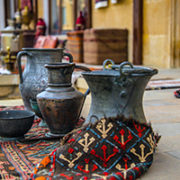Economics, Energy
 Environment, Finance sector development, Industry and trade
Environment, Finance sector development, Industry and trade
 Industry and trade, Urban development
Industry and trade, Urban development
 Economics, Industry and trade
Economics, Industry and trade
 Industry and trade
Industry and trade
 Health, Poverty, Social development and protection
Health, Poverty, Social development and protection
 Economics, Finance sector development, Industry and trade
Economics, Finance sector development, Industry and trade
 Economics, Governance and public sector management
Economics, Governance and public sector management
 Economics, Governance and public sector management, Industry and trade, Regional cooperation and integration
Economics, Governance and public sector management, Industry and trade, Regional cooperation and integration
 Finance sector development, Industry and trade, Infrastructure, Regional cooperation and integration
Finance sector development, Industry and trade, Infrastructure, Regional cooperation and integration

What are the reasons behind the decrease in solar module prices?

The solar photovoltaic energy market has seen huge growth in recent years. Unlike solar thermal energy, which harnesses heat from sunlight to generate electricity, solar photovoltaics or PV is a technology that converts sunlight directly into electricity. The annual worldwide solar PV electricity production increased from 4 terawatt hours (TWh) in 2005 to 247 TWh in 2015 (IEA 2017). In 2016, cumulative solar PV generated over 310 TWh, 26% higher than in 2015 and representing just over 1% of global power output.
Sustainable funding schemes for the development of waste management projects in Asia

For many years, cities have been the engines of economic growth in Asia. However, this growth has brought the immense challenge of the daily generation of millions of tons of solid waste, especially in mega cities. The amount of solid waste being generated in Asia is drastically increasing as 44 million people are being added to city populations every year, and many cities are placing burdens on municipal as well as central governments. By 2050, 50% of the world’s population will live in the Asia and Pacific region (ADB, 2011).
High-speed rail investment: A butterfly effect for urban chaos

In 1969, Professor Edward Norton Lorenz coined the term “butterfly effect” to state that subtle changes in conditions can influence or cause seemingly unrelated results elsewhere. The flutter of a butterfly’s wings at place A can eventually develop into a hurricane at place B even though A and B are not related. Almost two decades after the term was coined, Japan National Railways (JNR) was privatized and split into several corporations, and now JR East manages the largest network of railway lines in Japan.
Volatility linkages between energy and food prices

Energy, especially from oil and its derivatives, is a key factor of production in an economy and is widely used in different sectors—including transportation, agriculture, and industry—in households, and as a raw material in the production of petrochemical products. As such, energy has great value and affects other commodity prices. Since the first oil price shock of 1973, examining the effects of changes in energy prices, especially of oil, on macro and microeconomic levels has become one of the most fundamental issues of energy economics (Taghizadeh-Hesary et al. 2013).
Dismissal laws, innovation, and economic growth

The appropriate degree of government intervention in private contractual relationships, particularly in employment law, remains a fraught public policy issue. In arguing the detrimental effects of laws that prevent employers from terminating labor contracts with employees, flexible labor market conditions in the United States (US)—exemplified by the common-law “employment-at-will” doctrine—are often contrasted with the rigidities engendered by employment protection provisions in several European countries.
Is Indonesia’s subsidized rice program benefitting its children?

Indonesia’s subsidized rice program, RASKIN (also known as Operasi Pasar Khusus), constitutes the longest running and the largest in-kind transfer for poor households in Indonesia. In 2010, government expenditure on RASKIN accounted for 53% of the total household-targeted social assistance. What has been the impact of this program on child health in Indonesia? Our recent paper (Gupta and Huang 2018) is, in this regard, the first attempt in the literature to analyze this issue in the context of Indonesia.
Young Small and Medium-Sized Enterprises and Bank Credit Denials: Evidence from Europe

It is widely accepted that small and medium-sized enterprises (SMEs) represent the backbone of most economies. Not surprisingly, the story is mostly the same across the globe. For instance, Yoshino and Taghizadeh-Hesary (2014) report that SMEs account for almost 98% of all enterprises in Asia, offering jobs to around 66% of the workforce. In the European Union, the data offer a similar picture. In fact, SMEs represent 99% of all non-financial enterprises and account, on average, for 67% of total employment (European Commission 2017). Overall, such figures undoubtedly highlight how pivotal SMEs are for the functioning of the real economy.
What Do Structural Economic Reforms Promise for the Future of Azerbaijan?

After the oil price crunch in mid-2014, Azerbaijan entered into a new stage of economic development. During 2004–2014, thanks to high oil prices, Azerbaijan achieved substantial growth rates, which were accompanied by improved social conditions and macroeconomic stability. Azerbaijan’s average annual growth rate during 2000–2013 of 11.3% played a key role in the improvement of the country’s international economic ranking.
Impact of Retaliatory Trade Enforcement Actions on the World Trade Organization and Trade Governance

The international regulatory instruments in international trade boast a remarkable story of evolving sophistication. Their transformation from voluntary export restraint agreements showed that the world trade system was poised to keep pace with rapidly expanding trade ties and diversifying supply chains. To keep the reins on an increasingly dynamic global trade system, the General Agreement on Tariffs and Trade (GATT) sought to formalize instruments that would help keep trade balanced and fair by isolating international trade from government intervention, in alignment with the economic thinking of the period: neoliberal convergence.
Next generation of quality development and investment in the new Pacific trade pact

Earlier this month, the Pacific trade pact was reborn in Santiago as the 11-nation Comprehensive and Progressive Agreement for Trans-Pacific Partnership. While the headlines have been dominated by the absence of the United States and the level of trade gains each nation hopes to enjoy, let’s focus here on three less-remarked-upon sections of this revised treaty among Australia, Brunei Darussalam, Canada, Chile, Japan, Malaysia, Mexico, New Zealand, Peru, Singapore, and Viet Nam (the TPP11).


Search
Subscribe / Connect to Asia Pathways
Subjects
- Accelerating Progress in Gender Equality
- Addressing Remaining Poverty and Reducing Inequality
- Agriculture and natural resources
- Capacity development
- Climate change
- Economics
- Education
- Energy
- Environment
- Finance and Innovation
- Finance sector development
- Gender
- Globalization and Economic Stability
- Governance and public sector management
- Health
- Human Capital Development for Inclusive Growth and Shared Prosperity
- Industry and trade
- Information and Communications Technology
- Infrastructure
- Making Cities More Livable
- Miscellaneous
- Population
- Poverty
- Private sector development
- Regional cooperation and integration
- Sanitation
- Social development and protection
- Strengthening Governance and Institutional Capacity
- Subjects
- Transport
- Uncategorized
- Urban development
- Video Blog
- Water
Recent Posts
- The Promise and Perils of Mother Tongue-Based Education
- From Crisis to Resilience: The Evolution of the Banking Sector in Asia and the Pacific
- Tariffs on the Table: What Could Be Asia’s Next Move?
- Investing in Childcare a Win for Women and the Economy
- Flush and Flourish: Upgraded Toilets Can Transform Lives in Rural Asia




Recent Comments